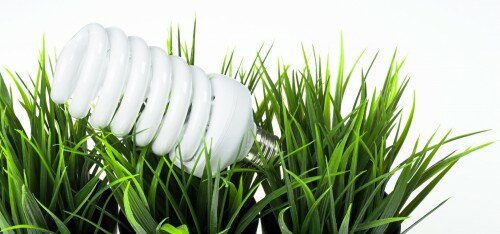Energy Efficient Lighting
 In recent years energy use for household lighting in Australia has rapidly increased. This is due to the construction of larger homes and the installation of more light fittings per home. Lighting consumes between 8 and 15 per cent of the average household electricity budget.
In recent years energy use for household lighting in Australia has rapidly increased. This is due to the construction of larger homes and the installation of more light fittings per home. Lighting consumes between 8 and 15 per cent of the average household electricity budget.
Most households could reduce the amount of energy they use for lighting by 50 per cent or more by making smarter lighting choices and moving to more efficient technologies.
In Australia traditional but inefficient types of lighting (incandescent) are being phased out. There are other more efficient types of lighting available, including compact fluorescent lamps, LEDs and fluorescent lights. CFLs and good quality LEDs are the most energy efficient of these options. Use of natural light through windows, skylights, and light tubes which capture daylight and pipe it into dark corners of your home is another effective option to consider and can reduce your need for other forms of lighting.
Fluorescent lights are very energy efficient. They might be more expensive than incandescent globes but they use 80 per cent less energy and can last 4 to 10 times longer. They’re ideal for areas where lighting is required for long periods of time, such as the living room and kitchen. They also produce less heat, helping keep your home cooler in summer.
There are two main types of fluorescent lamps—compact fluorescent lamps and tubular lamps (fluorescent tubes).
Compact fluorescent lamps
CFLs can now be used in most light fittings, including older style incandescent fittings (screw or bayonet) and will provide you with energy-efficient lighting that’s also comfortable for your eyes.
CFLs are cheaper and much more efficient to run than incandescent lights. For example:
- If you use incandescent lights to light a large room like your lounge room, you could reduce your costs by about 80 per cent by converting to CFLs.
- If you want to use mains voltage halogen lights in the same type of room, you could be paying 4 times as much in lighting costs.
There are a few things to remember when using CFLs:
CFLs cannot be used with dimmer controls unless labelled ‘dimmable’. This may damage the control and the lamp.
CFLs shouldn’t be used in enclosed fixtures unless especially designed for them as they need to be reasonably well ventilated.
Fluorescent tubes
Tubular lamps, also known as fluorescent tubes, are available in a straight or circular style. They are cheaper to buy than compact fluorescent lamps (CFLs), but unlike CFLs require special fittings. Tubes are ideal for kitchens, garages and workshops.
LED’s
Good quality LEDs can provide excellent lighting in a range of household situations. LED lighting technology is developing rapidly and is already offering useful alternatives to some traditional lighting technologies such as downlights.
Compared to a 100W incandescent bulb that lasts for 2,000 hours, LED lights can last 50,000 hours. You’d need to replace the incandescent 25 times before you would need to replace the LED. The longer lifespan means fewer bulbs get thrown out and, in fact, many LED lights can be recycled, saving landfill space and easing demand for the raw metals used in their construction.
LED lighting uses far less electricity than other types of bulbs. A 9W LED can emit the same amount of light as a 100W incandescent. Lower wattage requirements mean less strain on the electrical grid, less greenhouse gas emissions from the power plant that supplies the electricity, and a reduced carbon footprint for your home. What’s more, LED lights run cooler and pose less of a fire or burn risk than incandescent or fluorescent lighting.
However there is significant variation in product quality. Some lower quality LEDs sold may not provide you with enough light, may flicker when dimmed, change colour through life or fail prematurely. Kelso Electrical use only the best quality in lighting, give us a call for an no obligation quote today!
Use these tips to help reduce your household lighting:
- Replace incandescent bulbs with CFLs, especially in rooms where lights are on for long periods
- Use the lowest wattage bulb required to meet each room’s lighting needs
- Turn off the lights of unoccupied rooms
- Turn outside lights off when you’re not using them
- Consider using timers and sensors for outdoor lights
- Regularly dust your low energy light bulbs and fittings
- Make the most of natural light. Open curtains and blinds during daylight hours
When you’re wiring up your home, allocate one switch per light rather than turning on multiple lights with the one switch
- Use two-way switching in rooms with two exits to ensure lights are turned off when leaving the room
- Use table or floor lamps fitted with CFLs where most light is required so that you don’t light unoccupied areas of the room
- Choose light fittings that allow most of the light through so a lower wattage lamp can be used. Some light fittings can block 50% or more of the light, especially those with coloured glass
For more information on how you can save money using energy efficient lighting give us a call on or come in and see us!
Safety Switches Save Lives
 Did you know that each year many Australians are killed in preventable electrical accidents and even more are hospitalised with severe burns or other injuries? The frustrating thing is that these deaths and injuries can almost certainly be prevented with the installation of safety switches.
Did you know that each year many Australians are killed in preventable electrical accidents and even more are hospitalised with severe burns or other injuries? The frustrating thing is that these deaths and injuries can almost certainly be prevented with the installation of safety switches.
Many Australian homes and businesses do not have up to date safety switches installed on their circuits. Most premises are still installed with out-dated fuse or circuit breaker protection, meaning that under the circumstance of electrical shock to humans or pets these devices may take anywhere from 4-6 seconds to trip or even worse may not even trip at all.
An electric shock of just a few milliamps can stop the heart, causing death.
With electrical appliances being such a big part of our everyday lives, electrical safety should be in high consideration. Thankfully the current technology of RCD safety switches saves lives.
Cost effective ways to install these devices allow you, your friends, family and employees to live and work at the safest possible standards giving you in peace of mind.
It is now law that all business premises must have RCD safety switches installed for the safety of employees with a three-monthly safety switch testing roster held on site at all times. Without this, businesses may face hefty fines under WH&S regulations.
To help you understand the dangers involved in old style fuses, circuit breakers and unprotected circuits, Kelso Electrical is offering a free inspection of your switchboard and premise. After the inspection you will receive a report explaining the type of protection you have and the improvements (if any) that you require in order to meet current standards and ensure your home or business premises operates in the safest possible environment.
Give us a call or come in and see us!
For more of our latest news check out our Facebook page!



